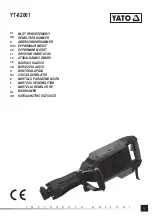
5
DT4600 Pneudraulic Installation Tool (HK1174)
Principle of Operation
When the trigger is pressed, the throttle valve moves to
the PULL position, and pressurized air is directed through a
tube to the bottom of the air piston, causing the air piston
to move upward. The air above the air piston is exhausted
and directed through the ports in the front of the tool.
As this happens, a column of hydraulic fluid is forced
through a passage in the tool head, causing the hydraulic
piston in the head to move rearward. The attached nose
assembly moves with the hydraulic piston to start fastener
installation.
When fastener installation is completed, the trigger is
released. Air pressure sends the throttle valve to the
RETURN position. Pressurized air is re-directed to the top
of the air piston, causing the air piston to move downward.
The air from below the piston is exhausted through the
tube and outside the tool.
The HUCK DREAM TOOL DT4600 ships with a plug in the
air inlet connector. The connector has 1/4-18 female pipe
threads to accept the air hose fitting. Huck recommends
quick-disconnect fittings and a 1/4” inside-diameter air
hose. The air supply should be equipped with a filter-
regulator-lubricator unit, and access to a 90 psi (6.2 bar)
air supply capable of 20 ft³/s (.57 m³/s).
NOTE: Air quick-
disconnect fittings and air hoses are not available from
Huck.
1. Remove the shipping plug from air inlet connector and
add a few drops of an approved hydraulic fluid
.
2. Screw the quick-disconnect fitting into the air inlet
connector.
3. Set the
air pressure on the regulator to
90
psi (6.2 bar),
and connect the air hose to the tool.
4. Press and release the trigger a few times to cycle the
tool.
5. Disconnect the air hose from the tool, and remove the
retaining nut.
6. Select the correct nose assembly for the fastener to be
installed.
7. Screw the collet assembly (including the lock collar and
shim if applicable) onto the spindle and tighten with a
wrench.
8. Slide the anvil over the collet assembly and into the
counterbore. Slide the retaining nut over the anvil, and
screw the nut onto the head.
9. Connect the air hose to the tool and install fasteners
in a test plate of proper thickness with correctly sized
holes. Inspect the fasteners to ensure a complete
installation was accomplished.
This tool is equipped with a vacuum feature for pintail
evacuation and collection. (See Figures 6 and 7 for
components identification.)
To activate the vacuum feature:
1. Disconnect the air supply.
2. Remove Pintail Deflector or Pintail Bottle Assembly.
3. Loosen Vacuum Shut-off one full turn.
4. Attach Pintail Bottle Assembly, and tighten clamp onto
Hydraulic End Cap Assembly barb.
5. Attach to air supply.
NOTE: Air flow into the Pintail
Bottle Assembly should be audible.
6. Install a fastener in a test plate to ensure pintail
is drawn into the Pintail Bottle Assembly after the
Hydraulic Piston returns to the fully-forward position.
7. Repeat steps to adjust vacuum air flow, if necessary.
To deactivate the vacuum feature:
1. Disconnect the air supply.
2. Remove the Pintail Bottle Assembly.
3. Tighten Vacuum Shut-off.
4. Re-attach Pintail Bottle Assembly or Deflector.
5. Attach to air supply. Air flow should not be audible.
Preparation for Use
Vacuum Feature
































